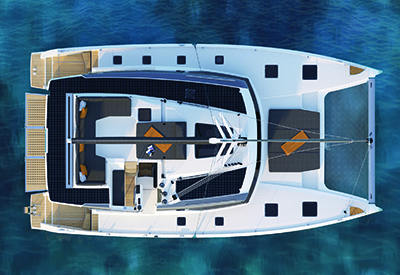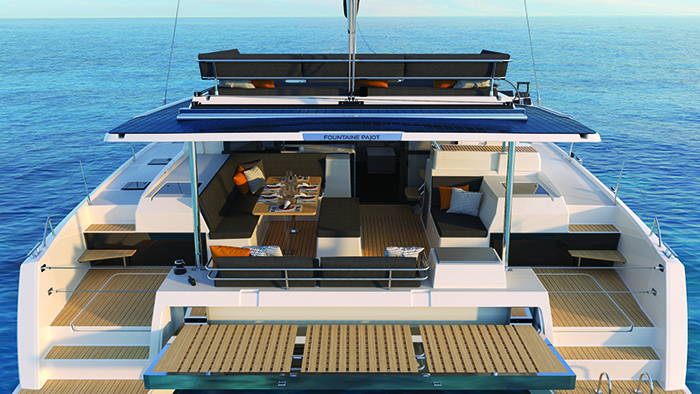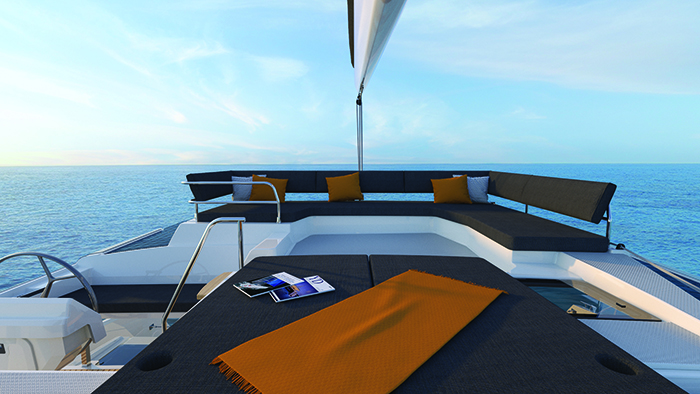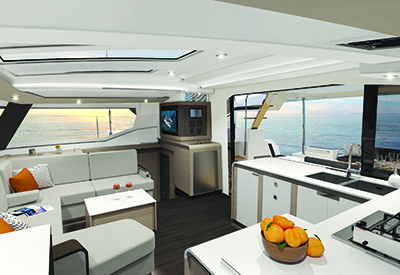Fountaine Pajot Tanna 47
By Zuzana Prochazka
Proven hull, flashy new style
Catamarans in the mid-40-foot range have become wildly popular. This is the sweet spot for both cruisers and charterers and many companies have rushed to gain traction in this lucrative segment. French builder Fountaine Pajot already has a leg up in this space with their 42-, 45- and 47-foot models but, knowing that the competition is fierce, they didn’t rest on their laurels. Instead, they reinvented their popular Saona 47 and transformed it into the Tanna 47 which launched at fall boat shows.
The new model builds on a proven hull design (which she shares with her predecessor) and adds a new deck, cabin house, interior layout and improvements which were first introduced on her larger sibling, the Aura 51. The results have clearly captured the imagination of buyers since several units of the new design sold just from drawings, well before the first Tanna 47 even splashed.

On Deck
The Tanna 47 isn’t just a refresh of an existing model. The deck and Bimini are a new design and include a revamped flybridge which is now 40% larger than before with 75 square feet of lounge area that accommodates up to 10.
The key to the Tanna 47 is ample deck space as seen from any angle.
The helm is on the bulkhead to starboard and its mid-level placement has several benefits: 1) The skipper is connected to everyone in both the cockpit and on the flybridge so there’s no lack of companionship or communication while driving. 2) Since the helm is at the main deck level, it’s easy to step out onto the side deck to help with dock lines or to get a better view along the starboard hull when pulling into a slip. 3) The helm is elevated so sightlines are good forward and you can also duck under the Bimini for a clear view of the port transom. 4) There’s separation between the helm with the wheel and throttles, and the line handling area with the winches, so multiple crew can work together without getting in each other’s way. This helm station follows improvements made on the 51-foot sistership and even the smallest of details were addressed such as the placement of the autopilot that is now to the right of the wheel for better access.
The Bimini has been put to good use beyond just flybridge comfort. The builder is focused on energy autonomy, especially during extended stays at anchor, so a large portion of the Bimini top has been dedicated to the placement of integrated solar panels. In fact, you can now choose to add 700-1700 watts of power which can keep this cat self-sustaining for days. For those who cannot manage the tropics without air conditioning, there’s also an optional 11.5 kW Northern Lights genset.

The generous aft cockpit and the hydraulic “teak beach” are guest favourites
There’s no shortage of gathering spots aboard and large groups will have plenty of options to spread out. If the flybridge isn’t your thing, there’s a triple sunbed on the foredeck where to enjoy a good book, or you can join the rest of the crew in the large aft cockpit with its L-shaped dinette, a wide transom seat and a double lounge.
A luxury feature you may want to consider adding is the electric swim platform. This can be a pricey option but it’s worth it for four reasons. 1) It can carry an 11-foot tender without having to haul a heavy load onto davits. 2) It allows a quick traverse from one hull to the other without having to dodge people in the cockpit. 3) It’s a wonderful teak beach where you can get ready to go diving or snorkelling or play with the kids. 4) It’s a handy way to come up from the water without having to use a slick and narrow ladder. In fact, for kids, pets or older folks with tricky knees, this can be a lifesaver.
Living Aboard
Step from the cockpit to the interior via the wide sliding glass door which is now 20% larger so the airflow is better and there’s more room for people to pass. The cabin house windows are larger too and there are twin skylights overhead for an abundance of natural light.
The galley is in the port aft corner, facing the opening window that leads to the cockpit. The oven has been relocated to below the countertop which makes it safer (no more hot liquids at chest level). Two large fridge drawers are in the port forward corner. This new configuration makes it easier for multiple cooks to work together without feeling crowded.

the flybridge is 40% larger than before
The new saloon layout follows the one designed for the Aura 51. An L-shaped settee is to starboard connected to an aft-facing lounge which will probably become the most popular seat in the house for both its comfort as well as the USB port integrated into the armrest that keeps devices charged.
The nav desk was moved aft to a small space near the sliding doors. It’s both good and bad. It offers quicker access from the cockpit and helm but it’s not a dedicated navigation station. It’ll be great on charter but for private owners on long passages, there’s not a convenient nor comprehensive way to drive from the inside in inclement weather.
Like other FP designs, the Tanna 47 is sold in three options packages and multiple layouts. The Maestro version offers a massive owner’s suite that makes you catch your breath when you first pop down the steps into the port hull. It’s an impressive private space divided into sleeping quarters aft, a vanity and multiple storage lockers amidships, and a massive bath forward with room for a washer/dryer installation. Nobody will be roughing it in this stateroom.

The Quintet version offers five cabins (all ensuite) and will be ideal for charter. In this layout, there are still two cabins in the starboard hull but the port hull now adds a double stateroom forward and a single cabin amidships. Then, there’s another double cabin aft with its own head and separate access from the cockpit. This stateroom will be ideal for a captain/chef combination crew or guests who like to have their separation.
the galley, saloon and nav desk flow together seamlessly.
As mentioned above, much of the interior design was borrowed from the Aura 51 and it’s impressive that so much has been accomplished on a platform that’s four feet shorter.
Performance
Unlike other production cat builders, Fountaine Pajot decided to forgo a self-tacking jib and instead, offers this model with a 120% overlapping genoa. The genoa tracks are nearly twice as long as before for better headsail trim options. It’s also nice to see three winches at the helm station so you don’t have to keep locking off sheets and reefing lines with jammers to free up winch space which makes line management easier, faster and more efficient.
We tested the Tanna 47 on Chesapeake Bay in a healthy 12-14 knots of true wind. It was the ideal combination of calm water and a perfect breeze and we sailed 6.7 knots at 60 degrees apparent wind angle (AWA). That increased to 7.5 knots on a beam reach and then dipped to 6.2 knots when we cracked off to 120 degrees AWA. The Tanna 47 moved well and made wide arcing tacks. It felt like driving a Cadillac as we moved through the light chop.
Standard power includes twin 60-hp diesels but we had the upgraded Volvo Penta 75-hp engines with folding props which pushed us along smartly at 8.3 knots at 2400 rpm. (Max speed was 9.1 knots at 2900 rpm.)

One note when under power: FP cats are designed with hydraulic steering which doesn’t provide the same kind of feedback as direct drive and it takes a bit of getting used to. First, you can’t lock off the wheel on the centerline if you choose to maneuver with just the throttles and if the rudders swing freely, that can create counterintuitive results in tight situations. Additionally, the rudders are forward rather than aft of the props. This changes the timing of the water flow over the rudders and also the pivot point of the boat. Driving with these elements isn’t anything that can’t be mastered but it does take time to develop comfort and skill.
there’s an easy connection between the inside and outside with easy sinlge-level living.
Space in Spades
The new FP Tanna 47 is all about space – and clever ways to use it. You’d be hard-pressed to find a cat of this size that offers more conversation nooks and gathering spots. That Fountaine Pajot managed to create something so refreshingly new on an existing platform is noteworthy so kudos to the designers. Their skill works to your advantage as does the fact that you can test this model in charter for a week to determine if she fits your long-term needs. Happy sea trials.
Specs for FP Tanna 47
LOA 45’ 8”
Beam 25’ 4”
Draft 3’ 11”
Displacement 29,400 lbs
Sail Area 1,388 sq ft
Power 2x 50-hp (upgrade 2x 60-hp)
Designer Berret-Racoupeau
Builder Fountaine Pajot/catamarans-fountaine-pajot.com
Price as tested $1,100,000 USD























